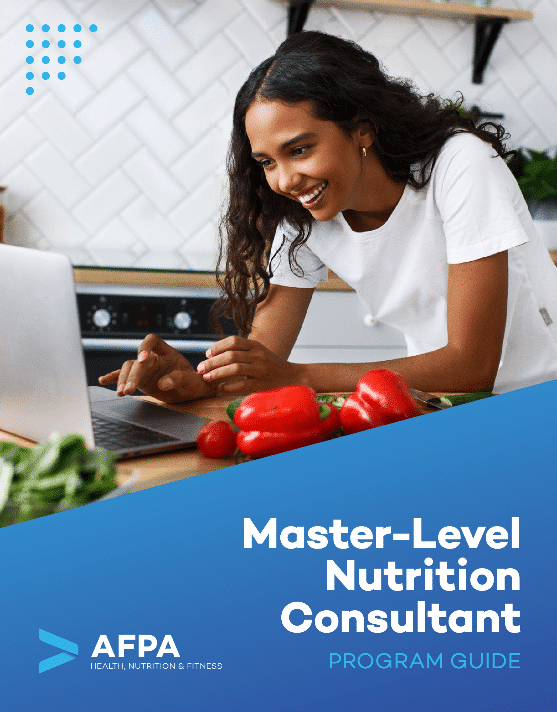Table of Contents
Social media heavily influences people’s perceptions of nutrition, eating habits, and body image. Platforms like Instagram and TikTok expose users to a constant stream of health and wellness messages that can inspire positive change, but that can also contribute to misinformation, unrealistic expectations, and unhealthy comparisons. As a health and nutrition coach, it’s important to understand how these messages influence your own perspective and the behaviors of those who don’t have a strong foundation in nutrition. Acknowledging this impact allows you to better guide clients in developing a balanced approach to health and help you curate your own content responsibly. Learn the ins and outs of how social media affects eating habits—and how to create meaningful, positive content—by exploring social media’s role in food and eating habits.
Social media is deeply woven into daily life, influencing everything from shopping habits to career growth and even health and nutrition decisions. With an endless stream of content, users are constantly exposed to messages about food, body image, and wellness from influencers, brands, and experts. These messages can subtly or overtly influence eating habits, perceptions of health, and personal goals, often without people realizing it.
For health and nutrition professionals, it’s important to consider the impact of these messages—not only on clients but also on the broader audience consuming this content. What people see on platforms like Instagram and TikTok can reinforce positive behaviors or contribute to confusion and unrealistic expectations. By being mindful of these influences, you can better navigate and lead online nutrition conversations and create content that promotes balanced, evidence-based habits.

Become an Expert Nutrition Coach at Your Own Pace
Download your free guide now.
Social media influencers are under constant examination, both from their audiences and the platforms they use. Their content is often shaped not only by personal beliefs or verified expertise but also by algorithms, sponsorship deals, and engagement metrics. While some genuinely aim to educate or inspire, many influencers rely on partnerships with brands or ad revenue to make a living, which can influence the way they present information.
This blurred line between authentic sharing and strategic promoting makes it important to view influencer content with a critical eye. What may appear to be unbiased advice or personal experience may actually be strategically crafted and brand-directed messaging designed to drive engagement or sales. Understanding these dynamics can help you and your clients better evaluate the credibility of the health and nutrition information on social media.
Who Influences Influencers?
As a health and nutrition coach, you specialize in understanding the complex and intertwined components that influence health behaviors. While influencers may present their views with confidence, it’s important to recognize the factors that contribute to their perspectives—whether they’re sharing genuine insights, reinforcing common narratives, or responding to financial incentives. Understanding these influences can help you and your clients critically evaluate the content they consume.
- Personal experiences – Their experiences with food and health may not reflect the mainstream or your own.
- Formal education – Their training or academic background can shape their views, but even structured education can present conflicting perspectives.
- Informal education – What they learn from reading, their job, or discussions with others can heavily shape their opinions.
- Profession – Their career may validate their expertise, but it doesn’t always align with formal education or deep knowledge.
- Access to information – Language barriers, social media algorithms, and internet literacy affect the quality of information they engage with.
- Circle of influence – Close friends, family, and trusted sources often shape their opinions more than authoritative expert
- Income or perk incentives – Financial motivation, sponsorships, and product endorsements can influence the information they share.
As you scroll through social media, keeping these factors in mind can help you better assess the credibility and intent behind the content you encounter.
Behavioral psychology suggests that people naturally try to align their behaviors with perceived social norms, including their eating habits. Before social media, these norms were shaped by cultural traditions, economic factors, and local food availability. People observed the eating patterns of family, friends, and their immediate communities to develop their own. Today, social media expands these influences far beyond personal interactions, exposing users to a constant stream of content that shapes their perception of what and how they should eat. Whether it’s through influencers, peers, or viral food trends, social media plays a powerful role in defining what is considered “normal” or desirable in nutrition.
Social Media Feeds Our Eating Habits—For Better or Worse
A recent study out of the University of Birmingham examined how Facebook users’ perceptions of food-related content in their social networks influenced their own eating habits. Researchers found that perceived social norms about food consumption significantly predicted users’ intake of:
- Fruit
- Vegetables
- Energy-dense snacks
- Sugar-sweetened beverages
The study found that when people believed their peers consumed more fruits and vegetables, they were more likely to do the same. Additionally, perceived norms around high-calorie snacks and sugary drinks also influenced consumption—whether encouraging or discouraging these choices. While this suggests that exposure to health-conscious content could promote better eating habits, it also raises concerns. If someone’s social feed is filled with fad diets, misleading nutrition information, or a lack of nutrient-dense food representation, it may negatively impact their dietary choices.
Edited Selfies and the Idealization of Thin Bodies on Social Media Can Lead to Disordered Eating
Pictures of food and content about what nutritionists and fitness experts eat in a day aren’t the only factor influencing eating habits. In Western culture, it is no secret that thin, lean, hourglass-shaped female bodies and lean and muscular male bodies are considered “ideal” and generally associated with greater attractiveness and health. In reality, research demonstrates that body shape and size have little to no impact on health, and it has been long-known that ideas of attractiveness are relative. Additionally, only a small percentage of bodies actually fit the culturally accepted Western body ideal.
How does this play out on social media? Studies show that when users’ feeds are flooded with images of bodies that seem to fit the culturally accepted ideal, they have lower self-esteem, feel shame, and feel the need to manipulate their diet to lose weight, gain weight, or gain muscle in the “right” places. This thinking leads to disordered eating, which is often misdiagnosed or hidden as healthy or disciplined eating habits.
While all sexes and genders are affected by selfie-triggered body shame, females and LGBTQ+ individuals seem to experience most shame.
Advertisements with Clear Messaging about Food Impact Eating Habits
Advertisements and paid promotions are sticky topics when it comes to describing their impact on behavior through social media. By definition, for-profit advertisements are designed to trigger an action that will lead you to make a purchase. Unlike traditional advertisements like television commercials, magazine sections, fliers, or billboards that are spaces exclusively for selling ideas, products, and services, advertising on social media isn’t always easy to distinguish.
A social media feed can include a picture of your cousin’s family and your friend’s opinion of a recent book they read, followed by a paid advertisement that follows the same format. If you aren’t looking for the “Sponsored” label or the #ad hashtag, the fact that a company paid for that content to show up on your feed can go unnoticed. As you look through your feed filled with people, companies, and organizations you chose to follow, advertisements get a boost over normal algorithms.
The question is—how do advertisements impact eating behaviors? Several studies have focused on the impact of food and beverage-related advertisements on eating behaviors, especially of children and adolescents. This is what researchers found:
- Exposure to content that centers on unhealthy food and beverages contribute to the adoption of habits that diminish health. Marketing companies employ images of family friendly events to sell unhealthy foods. Digital marketing spaces are largely unregulated, meaning that this content, which is easily shared, can have a significant impact on eating behaviors and can be considered by public health professionals as manipulative.
- Researchers examined the relationship between childrens’ engagement with food and beverage content and the consumption of unhealthy foods and beverages among children 10-16 years old. They found that children with higher online engagement with food brands and content, especially through videos, are more likely to consume unhealthy foods and drinks.
- Systematic reviews show that food and brand marketing adversely affects children’s diet quality and diet-related health.
- One study found that brands that include energy-dense, nutrient-poor food and beverages on Instagram use between 6 and 11 different marketing strategies in their Instagram accounts, most of which aim to manipulate consumer emotions rather than present information about their products.
Movements that Promote Intuitive Eating, Appreciation of Cultural Eating Patterns, and Body Acceptance Can Help Reverse the Damage of Social Media
Intuitive eating, Health at Every Size (HAES), body acceptance, and body positivity are all relatively new movements and approaches in the mainstream health and nutrition field. They are also controversial approaches to health and nutrition in some circles, and they may not speak to your personal philosophies.
Nonetheless, we cannot ignore the research that these movements have had a significantly positive effect on the mental and physical health of people of all different body shapes and sizes. Social media has the potential to add fuel to the fire of food shaming and food restriction that, as demonstrated in the previous two points, can lead to feelings of shame, trauma, and disordered eating.
The research shows the below approaches help to rectify the impact of social media on disordered eating behaviors and negative body image:
- When compared to a control group, people enrolled in a HAES intervention were less susceptible to hunger and inhibition (an indicator of self-esteem) than in the control group.
- In a systematic review of HAES interventions, it demonstrated a positive effect on mental health outcomes and physical activity. It also promoted positive changes in eating habits.
- An eight-year longitudinal study found that intuitive eating produces better psychological health and lower use of disordered eating behaviors.
- Body acceptance and body positivity movements on social media show a diversity of body types and sizes through fashion and beauty-related activism, physically active portrayals of people in bigger bodies, and a focus on holistic wellbeing. However, as with any movement in which the community contributes, these movements are not immune to contradictory messaging.
If health and wellness, rather than weight loss and body shape and size, is the goal of your coaching practice, you may want to consider adopting some of these frameworks and approaches.
Considerations for Influencers
Taking your health, wellness, or nutrition coaching business online has the potential to maximize your impact and reach, not to mention your income. However, the way you use social media matters. It’s important to consider the impact of the content you publish to your online audience. As you build your social media strategy to promote your brand and your business, here are three things to consider so your content positively contributes to long-term psychological and physical health.
- Make your recommendations realistic and achievable. Most of your followers aren’t full-time health professionals—they have jobs, families, and other responsibilities. If your recommendations are too time-consuming or financially demanding, they may feel discouraged rather than inspired. Keeping advice practical helps prevent unintentional shame or frustration.
- Think critically before sharing before-and-after photos, personal meals, or fitness routines. While these posts may seem motivating, they can sometimes trigger feelings of shame, unrealistic expectations, or disordered eating. However, if your content is transparent, relatable, and challenges unrealistic body ideals, it can serve a positive purpose—especially for those training professional athletes or needing structured guidance.
- Consider the impact of your content on children and adolescents. Young audiences often engage with content designed for adults, making them particularly vulnerable to messaging around body image and health. Be mindful of how your posts might influence younger viewers who are still developing their sense of self.
- Acknowledge diverse experiences and definitions of health. Promoting a single body type or eating pattern as the standard for health can alienate individuals with different cultural backgrounds, body sizes, or health conditions. Recognizing multiple paths to well-being makes your content more inclusive and expands your potential audience.
Main Takeaways
Social media plays a powerful role in shaping perceptions of health, nutrition, and body image. With endless content at their fingertips, users often turn to influencers and experts for guidance on eating habits and wellness. This creates opportunities to educate and inspire but also raises concerns about misinformation and unrealistic standards. As a health and wellness professional, you’re in a unique position to create and share content with a balanced, realistic approach to well-being—one that supports positive body image, resonates with real people, and embraces diverse perspectives on health.

Become an Expert Nutrition Coach at Your Own Pace
Download your free guide now.


